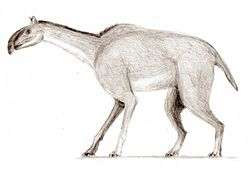Litopterna
| Litopterna | |
|---|---|
 | |
| Interpretation of Macrauchenia | |
| Scientific classification | |
| Kingdom: | Animalia |
| Phylum: | Chordata |
| Class: | Mammalia |
| Infraclass: | Eutheria |
| (unranked) | Mesaxonia |
| Superorder: | †Meridiungulata |
| Order: | †Litopterna Ameghino 1889 |
Litopterna (from Ancient Greek: λῑτή πτέρνα "smooth heel") is an extinct order of fossil hoofed mammals (ungulates) from the Cenozoic era that displayed toe reduction – three-toed forms developed; there was even a one-toed horse like form.
Evolutionary background
This order, known only from South America and Antarctica,[1][2] was common and varied in early faunas and persisted, in decreasing variety, into the Pleistocene. Early forms are near the condylarths, to such an extent that the litopterns might be considered merely as surviving and diversely specialized condylarths. They are suspected of being descended from South American condylarths, and therefore to have the same source as the latter. However, an opposing view has been that litopterns (together with other South-American ungulates) originated independently from other ungulates and thus are unrelated to condylarths. A proposed clade containing these groups is the Meridiungulata. Together with Neolicaphrium, Macrauchenia was among the youngest genera of litopterns, and these two appear to have been the only members of the group to survive the Great American Interchange; they became extinct at the end of the Pleistocene. Those that died out during this faunal exchange are presumed to have been driven to extinction at least in part by competition with invading North American ungulates.[3][4][5]
The Litopterna, like the notoungulates and pyrotheres, are examples of ungulate mammals that arose relatively independently in "splendid isolation" on the island continent of South America. Like Australia, South America was isolated from all other continents following the breakup of Gondwana. During this period of isolation, unique mammals evolved to fill ecological niches similar to other mammals elsewhere. The Litopterna occupied ecological roles as browsers and grazers similar to horses and camels in Laurasia.
Sequencing of mitochondrial DNA recently extracted from an Macrauchenia patachonica fossil from a cave in southern Chile indicates that Litopterna is the sister group to Perissodactyla, making them true ungulates. The estimated divergence date is 66 million years ago.[6] Analyses of collagen sequences obtained from Macrauchenia and the notoungulate Toxodon have led to the same conclusion, and add notoungulates to the sister group clade.[7][8] This contrasts with the results of some past morphological analyses which favoured them as afrotherians. It is consistent with some more recent morphological analyses which suggested they were basal euungulates. Panperissodactyla has been proposed as the name of an unranked clade to include perissodactyls and their extinct South American ungulate relatives.[7]
Families
- Order Litopterna — Litopterans (all members of the order extinct South American forms)
- Eolicaphrium
- Lambdaconus
- Paulogervaisia
- Proacrodon
- Proadiantus
- Family Protolipternidae - incertae sedis
- Superfamily Macrauchenioidea
- Family Adianthidae
- Family Macraucheniidae
- Family Mesorhinidae
- Family Notonychopidae
- Family Sparnotheriodontidae
- Superfamily Proterotherioidea
- Family Proterotheriidae
References
- ↑ M. Bond; M. A. Reguero; S. F. Vizcaíno; S. A. Marenssi (2006). "A new 'South American ungulate' (Mammalia: Litopterna) from the Eocene of the Antarctic Peninsula". In J. E. Francis; D. Pirrie; J. A. Crame. Cretaceous-tertiary high-latitude palaeoenvironments: James Ross Basin, Antarctica. The Geological Society of London. pp. 163–176. doi:10.1144/GSL.SP.2006.258.01.12.
- ↑ Gelfo, J. N.; Mörs, T.; Lorente, M.; López, G. M.; Reguero, M.; O'Regan, H. (2014-07-16). "The oldest mammals from Antarctica, early Eocene of the La Meseta Formation, Seymour Island". Palaeontology. 58 (1): 101–110. doi:10.1111/pala.12121.
- ↑ Webb, S. D. (1976). "Mammalian Faunal Dynamics of the Great American Interchange". Paleobiology. 2 (3): 220–234. JSTOR 2400220.
- ↑ Marshall, L. G.; Cifelli, R. L. (1990). "Analysis of changing diversity patterns in Cenozoic land mammal age faunas, South America". Palaeovertebrata. 19: 169–210. Retrieved 2018-10-08.
- ↑ Webb, S. D. (1991). "Ecogeography and the Great American Interchange". Paleobiology. 17 (3): 266–280. doi:10.1017/S0094837300010605. JSTOR 2400869.
- ↑ Westbury, M.; Baleka, S.; Barlow, A.; Hartmann, S.; Paijmans, J. L. A.; Kramarz, A.; Forasiepi, A. M.; Bond, M.; Gelfo, J. N.; Reguero, M. A.; López-Mendoza, P.; Taglioretti, M.; Scaglia, F.; Rinderknecht, A.; Jones, W.; Mena, F.; Billet, G.; de Muizon, C.; Aguilar, J. L.; MacPhee, R. D. E.; Hofreiter, M. (2017-06-27). "A mitogenomic timetree for Darwin's enigmatic South American mammal Macrauchenia patachonica". Nature Communications. 8: 15951. doi:10.1038/ncomms15951.
- 1 2 Welker, F.; Collins, M. J.; Thomas, J. A.; Wadsley, M.; Brace, S.; Cappellini, E.; Turvey, S. T.; Reguero, M.; Gelfo, J. N.; Kramarz, A.; Burger, J.; Thomas-Oates, J.; Ashford, D. A.; Ashton, P. D.; Rowsell, K.; Porter, D. M.; Kessler, B.; Fischer, R.; Baessmann, C.; Kaspar, S.; Olsen, J. V.; Kiley, P.; Elliott, J. A.; Kelstrup, C. D.; Mullin, V.; Hofreiter, M.; Willerslev, E.; Hublin, J.-J.; Orlando, L.; Barnes, I.; MacPhee, R. D. E. (2015-03-18). "Ancient proteins resolve the evolutionary history of Darwin's South American ungulates". Nature. 522: 81–84. doi:10.1038/nature14249. ISSN 0028-0836. PMID 25799987.
- ↑ Buckley, M. (2015-04-01). "Ancient collagen reveals evolutionary history of the endemic South American 'ungulates'". Proceedings of the Royal Society B: Biological Sciences. 282 (1806): 20142671–20142671. doi:10.1098/rspb.2014.2671. PMC 4426609.
Further reading
- McKenna, Malcolm C; Bell, Susane K (1997). Classification of Mammals Above the Species Level. New York: Columbia University Press. ISBN 978-0-231-11013-6.
External links
| Wikimedia Commons has media related to Litopterna. |
- An artist's rendition of a Macrauchenia, a representative genus of the Litopterna. Retrieved from the Red Académica Uruguaya megafauna page